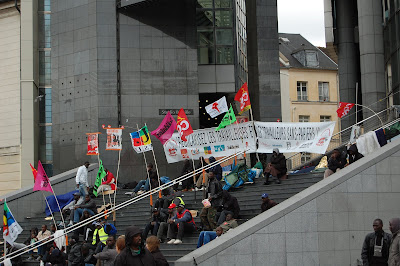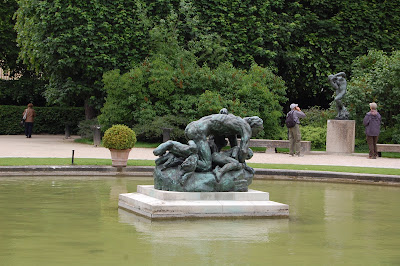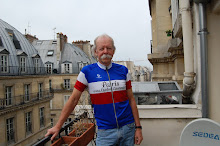Get along the best we can.
We rode the Metro out a bit for this morning's walk, then took a perhaps too long walk and then rode the Metro back in time for lunch. Our first stop just a few steps off the Metro was Porte Saint Denis.
 This was a gate in the Paris wall when Paris was a walled city. It was fairly exclusive as it was the king's entrance to the city. Whenever the king returned from outside the walls he came in through this gate. The gate indicates that it was built in 1673.
This was a gate in the Paris wall when Paris was a walled city. It was fairly exclusive as it was the king's entrance to the city. Whenever the king returned from outside the walls he came in through this gate. The gate indicates that it was built in 1673.Only a couple of blocks away is Porte Saint Martin. This is the nearby gate that was used by everyone who wanted to enter the city in that area who wasn't the king.
 Both of these gates are located on one of the Grand Boulevards. Space for building the Grand Boulevards in the late 1800s was made by tearing down the city walls. The Grand Boulevards are a tourist destination themselves and we continued walking along the boulevard we were on until we arrived at Place de Republique.
Both of these gates are located on one of the Grand Boulevards. Space for building the Grand Boulevards in the late 1800s was made by tearing down the city walls. The Grand Boulevards are a tourist destination themselves and we continued walking along the boulevard we were on until we arrived at Place de Republique. It was a very grey day and the photos are not always the greatest. I will try to run them through some photo shopping of some kind when I get home but for right now these are the images that I have. I am sorry but this is what it looked like in Paris this morning.
It was a very grey day and the photos are not always the greatest. I will try to run them through some photo shopping of some kind when I get home but for right now these are the images that I have. I am sorry but this is what it looked like in Paris this morning.We cut into the Marais to arrive at Place des Vosges. This is one of the first examples of a planned community, identical housing on all four sides of the square. Victor Hugo lived here. I was able to get a photo which included two tourist tour groups, both (I think) German. The bicycle group on the left is definitely German, the downtubes of the bicycles say www.parisbicycletour.net or something similar. The people with the orange hats and chartreuse backpacks on the right might possibly be Dutch as they all have "Amstel" hats. I listened briefly to both tour group leaders and was not able to differentiate clearly if they were German or Dutch.
 This is the Colonne de Juillet at Place de la Bastille.
This is the Colonne de Juillet at Place de la Bastille. The Bastille was torn down by the revolutionary mob. This column is dedicated to the heroes of 27, 28 and 29 July, 1830.
The Bastille was torn down by the revolutionary mob. This column is dedicated to the heroes of 27, 28 and 29 July, 1830.There was a political demonstration going on on the steps of Bastille Opera House. I had the French speaker translate the signs. The demonstration is by people who have documentation to work legally opposing workers "sans documents". She concluded it is more or less an anti-illegal immigrant demonstration. The Tea Party if you will.
 We walked along the Passage Plantee south of the Opera. It is an abandoned railroad viaduct which has been converted to a pedestrian way. It is about 4 kilometers long (we didn't walk the whole distance) and on a Sunday morning it is dominated by joggers. The other half of our traveling party was at the Jardin des Plantes so I wanted to be sure to get at least a tiny bit of horticultural content. The flowers are orange.
We walked along the Passage Plantee south of the Opera. It is an abandoned railroad viaduct which has been converted to a pedestrian way. It is about 4 kilometers long (we didn't walk the whole distance) and on a Sunday morning it is dominated by joggers. The other half of our traveling party was at the Jardin des Plantes so I wanted to be sure to get at least a tiny bit of horticultural content. The flowers are orange. Our afternoon excursion was to Musee Rodin. They have a big bronze at the nearest subway stop just to make sure you know that you are at the right place.
Our afternoon excursion was to Musee Rodin. They have a big bronze at the nearest subway stop just to make sure you know that you are at the right place. The Thinker. I have several other shots, I think this is an example of a photo which will improve greatly with a little back light but I don't have time to do it right now.
The Thinker. I have several other shots, I think this is an example of a photo which will improve greatly with a little back light but I don't have time to do it right now. La Porte d'Enfer, the Gates of Hell, in bronze, featured earlier in the week in plaster from Musee D'Orsay.
La Porte d'Enfer, the Gates of Hell, in bronze, featured earlier in the week in plaster from Musee D'Orsay. Ugolino, in the pool at the end of the garden.
Ugolino, in the pool at the end of the garden. Orpheus, hidden in the bushes on one side of the greenway back to the pool.
Orpheus, hidden in the bushes on one side of the greenway back to the pool. Balzac, next to the Thinker.
Balzac, next to the Thinker. Time grows short, we still have a couple of must do items left on the schedule. We shall see.
Time grows short, we still have a couple of must do items left on the schedule. We shall see.

2 comments:
A note on the Passage Plantee - it is often the backdrop for Parisian set French movies.
Very cool.
The gates of hell is my favorite.
Post a Comment